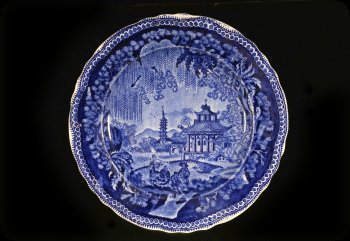“Palestine” Refined Earthenware Plate
In the early 1800s, potteries in the Staffordshire region of England were becoming more and more dependent on the American market at a time when relations between the two nations were sliding towards war. In the months leading up to the War of 1812, trade was suspended, and a financial crisis ensued that, according to pottery owner Ralph Stevenson, left one-third of pottery workers unemployed and 35 businesses shuttered. His business had just opened in 1810.
When trade restrictions were lifted following the war, Stevenson was among the first to capitalize. Plates produced at his pottery in Cobridge, Staffordshire, England, featured designs with a deep blue color, which proved popular in the American market for the next decade. This plate is typical of those in widespread use around the time Illinois became a state. It bears a transfer print pattern known as “Palestine.”





